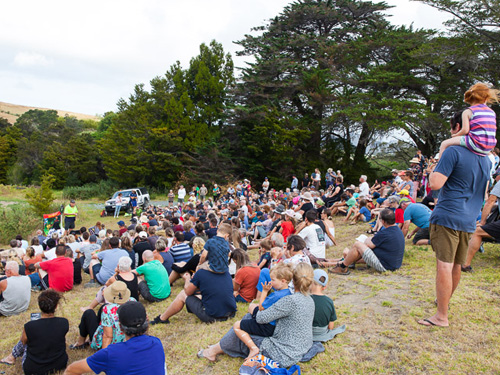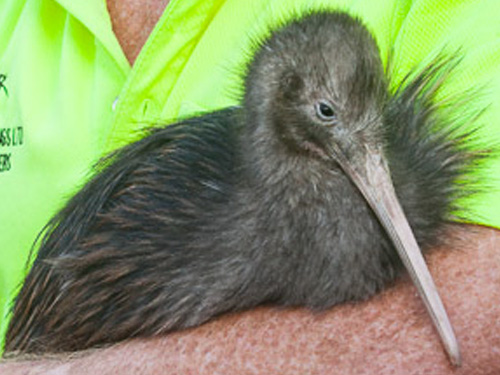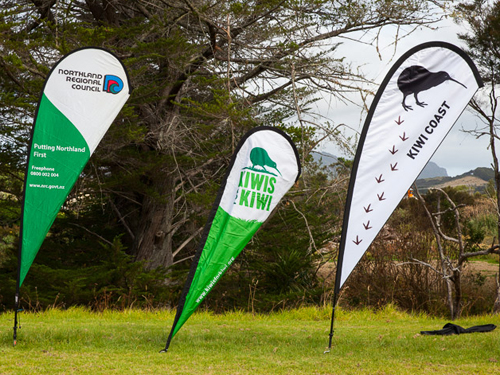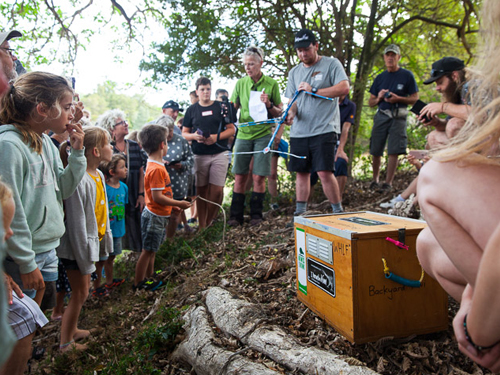2020 February Update
Successful Kiwi Release at Parua Bay
Thank you so much for the huge team effort that made the recent BYK release such a success. 400 locals got the thrill and privilege to welcome 5 more kiwi to the Parua Bay area, they also got the strong message about the need to control their dogs and walk them on a lead. Uncontrolled dogs are the biggest threat to our kiwi and these releases and follow up radio monitoring are the cornerstone of engaging the local community. Thanks to Ngati Hine, Purua farmers, DoC, FOMLI (the community group who manage the Limestone creche), Kiwi Coast, NRC, Kiwis for kiwi funding and the others for their support of our ONE and release program. The kiwi were two adult females “Hancock” and “Taonga” (named by Hancocks Forestry and North Power), a male named “Kohi” by Robyn Bigelow of WH Weed Action and Kohinui Landcare, and two young females (“Jemima named by FOMLI and “Kaitiaki” named by the Whangarei Deaf Community). See below for details of how they have settled in. Thanks to Wendy Brown for her great photos and Carolyn Comdon for the pic of Robyn & Kohi on face book
Upcoming Kiwi Releases
As part of our Kiwis for kiwi ONE program there are two more kiwi releases coming up: Tanekaha Landcare on Monday March 23 and Pataua North Landcare Sunday April 4. More details later on the Kiwi Coast website.
Northland Kiwi Hui
Kiwis for Kiwi are running a Northland Kiwi Hui on March 20-22 (Friday night to Sunday) at Te Tiriti O Waitangi Marae. Accommodation and meals provided. Registrations are now open.
https://www.kiwisforkiwi.org/events/northland-kiwi-hui/
Dead kiwi
The body of an adult female kiwi was recent found by a landowner at Ody road. She did not have an ID chip (transponder) so is a wild hatched bird and had been dead a while. The body has been sent to Massey University for an autopsy.
Extremely Dry conditions hard on kiwi chicks
As reported last month the extremely dry conditions mean that the young chicks are struggling to get a decent feed. Because the adult kiwi have sensibly put off their usual second round of nesting they are actually in good condition. The mums aren’t having to feed up to lay two big eggs and the dads have all night to feed instead of only a couple of hours when they are nesting so they are still doing ok.
Timing the annual kiwi listening call count is going to be tricky this year as the timing and intensity of the breeding calling will depend on when we get decent rain. At this stage the first listening window is the second half on May – I will update kiwi listeners when I know more.
Backyard Kiwi Predator Control Program :
After a quiet patch the trap catches have picked up with 7 stoats in the traps for February and 2 more already this month already.
February predator trap catches: Stoats 7, Weasels 2, Cats 3, Rats 54, Hedgehogs 16 and 6 possums.
Predator Free funding of increased pest removal work :
The proposed increase in pest removal (particularly of possums) funded by Predator Free in the Whangarei area is being progressed by the NRC and hopefully we will know more details soon.
What your radio tracked Backyard Kiwi have been up to:
Because of the ongoing dry conditions none of the monitored kiwi are nesting.
The recently released kiwi are making themselves at home in the damper wetland areas and feeding up on crickets in the nearby paddocks:
Kaitiaki – She has spent the last 2 weeks near the release area in the wetland in the Ross’s pines at the start of Taraunui Road, 11 hours activity.
Jemima – Spent a week in the wetland at the release area and now has headed off north down Taraunui Road to Ross Road, 9 hours activity.
Kohi – This adult male quickly moved down Taraunui road and has spent the last two weeks in the wetland near Malaika. Activity 10 hours.
Hancock – This adult female has moved east to the pine block between Owhiwa Road and Taraunui road, in the damp area deep in the valley there, 8 hours nightly activity.
Taonga – This female is in similar area to Hancock, 10 hours activity.
Whangarei Heads:
- Darwin – Still no signal since 4/12/19, which is concerning.
- Whitu – In the small wetland near the freezing works at Reotahi with 10 hours activity .
- EB – In the pampas opposite houses on Kerr road. Activity 9 hours.
- Pakipaki – In pampas in the horse paddock at McLeod Bay, 9.5 hours activity.
- Ross – Deep in a damp valley at the end of Pepi road. Activity 10 hours.
- Harikoa – Still in the wetland NE end of Campbell road, 11 hours activity. .
- Wally – Couldn’t find him for a while but he turned back up in the marshes on the edge of the pines at the end of Campbell road.10.5 hours nightly activity.
- Teina – Still in the young pine block east of Owhiwa road, 10 hours activity.
- Malaika – Still in the wetland on north-west side of Taraunui Road, Recently released Kohi is now nearby and they must be hearing each other, 10.5 hours activity.
- Awhi – She is still in the wetland on Campbell rd near to Harikoa. Activity is 11 hours.
Rarewarewa – no nesting activity.
- Nick – usual area in Lovell’s Bush, 9.5 hours activity.
- Sancho – usual area NE reserve with 9.5 hours activity .
- Moeahu – Near the old slip NE reserve. Did his six monthly check, heaps of ticks, PM condition, 10 hours activity.
- Kimposter – Usual area SE reserve, 9 hours activity.
- Ngutu Roa – SW reserve. Activity 9.5 hours.
- Ngaro – above the airstrip, 9 hours activity.
Cheers Todd
Backyard Kiwi Project Manager
Whangarei Heads Landcare Forum
M 021 1145 385
E todd.hamilton64@gamil.com
















